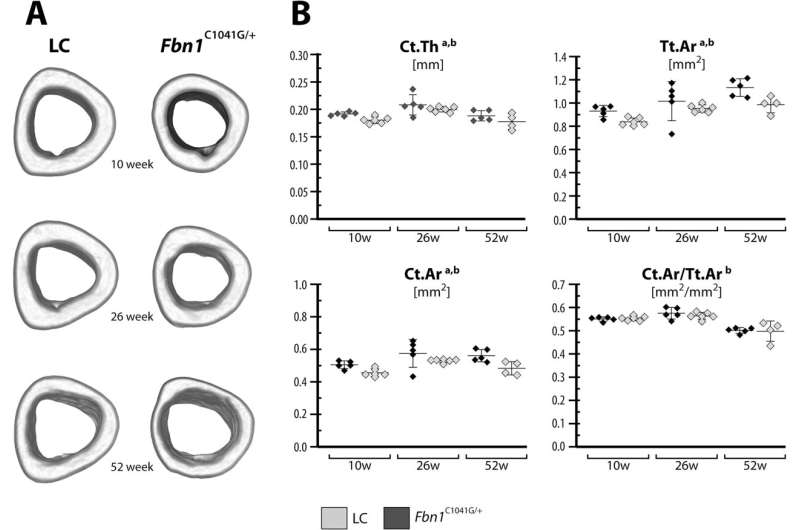This article has been reviewed according to Science X's editorial process and policies. Editors have highlighted the following attributes while ensuring the content's credibility:
fact-checked
trusted source
proofread
Reducing risk of bone fracture in people with rare genetic disorder

Our bones are the internal framework of our body. They're typically dense—providing the support we need to walk, run, and jump—and they're resistant to fracture. But in people with the rare genetic disorder Marfan Syndrome (MFS), bones are less dense and those in their arms and legs grow longer than normal.
Researchers from McGill University and Shriners Hospitals for Children Canada recently used the Canadian Light Source (CLS) at the University of Saskatchewan (USask) to study the bones of mice with MFS, in the hopes of better understanding the condition in humans.
"The fact that we don't understand the bone structure in people with MFS is a big problem, because they're at a higher risk of fracture," says Dr. Elizabeth Zimmermann, assistant professor at McGill University and researcher for Shriners Hospitals. "The aim of the study was to understand what could possibly be the cause of that."
She and her team used the BMIT beamline to compare the structure of bones affected by MFS to typical bones. The findings are published in the journal Matrix Biology Plus.
Bones are porous, meaning they're built like sponges, with tiny holes inside that allow fluid to move through them. Zimmerman and her team found that, in the bones with MFS, the pores were much smaller than those in typical bones.
"The Canadian Light Source played a huge role in our research," says Zimmermann. "We were able to identify the mechanics and structure of the bone with MFS at an incredibly small and detailed level."
Based on what they learned, they are now turning to exploring whether MFS causes changes in mechanosensation, the process by which bones sense mechanical force—specifically the pressure of the fluid flowing through the bones' pores.
"When astronauts go to space, they actually lose bone density, because there's no force being put on their bones," explains Dr. Bettina Willie, professor at McGill and investigator at Shriners Hospitals. "Another example is the tennis player, as they have more dense bone in their playing arm than their non-playing arm, because there's so much more force being put on the arm they hit the ball with."
Because people with MFS have much smaller pores in their bones, causing fluid to move through the bone differently, mechanosensation is a possible explanation for why they're at increased risk for fractures.
"At the synchrotron, we were expecting to see longer bones, we were expecting to see lower density—we knew these were likely," says Willie "In contrast, we were hoping to find changes in the pore structure, so it's exciting that what we hoped for was really there."
Deepening our understanding of mechanosensation could lead to ways of reducing the risk of fracture for the estimated 1 in 3,000 to 5,000 Canadians who live with MFS or a related connective tissue disorder, improving their quality of life, and that of the wider community living with lower bone density, including people with osteoporosis, diabetes, COPD, and rheumatoid arthritis.
More information: Elizabeth A. Zimmermann et al, Tissue material properties, whole-bone morphology and mechanical behavior in the Fbn1C1041G/+ mouse model of Marfan syndrome, Matrix Biology Plus (2024). DOI: 10.1016/j.mbplus.2024.100155



















